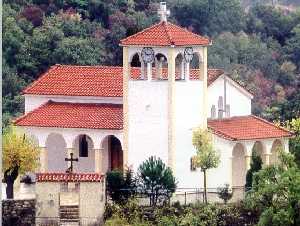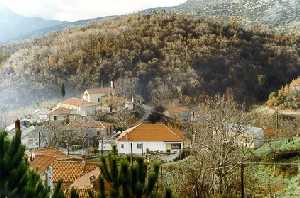|
|
Messinia
 Kalamata: The Lady of the
Messinian Bay ... Kalamata of the Kalamatianos dance and of
the silk scarf, Kalamata of the tasty black olives, of the
ripe figs, of the famous "pasteli"(a sweet made of
honey and sesame seeds). The Messinian capital, on the one
side is being surrounded by the deep blue Messinian bay, and
on the other side by the mountain Kalathi. The village Kato
Verga, is built to the western side of the mountain as a
"balcony overlooking the Messinian bay". In the days
of Homer, kalamata was called Pharae and later received its
present name from an icon depicting the Virgin Mary with very
beautiful eyes - Kalo mata (beautiful eyes) - which was
found in the Byzantine Chapel in the North Wing of the Castle
of Kalamata. During the Byzantine years, Kalamata was an
important center of Medieval civilization, whilst it was from
Kalamata that the victorious Greek Revolution of 1821 started
in the small church of Holy Apostles, which is present up to
today, at the center of the old market and which was built in
the year 1150. Above the city dominates the castle which was
built in 1028 by William Villherdouine.
Kalamata: The Lady of the
Messinian Bay ... Kalamata of the Kalamatianos dance and of
the silk scarf, Kalamata of the tasty black olives, of the
ripe figs, of the famous "pasteli"(a sweet made of
honey and sesame seeds). The Messinian capital, on the one
side is being surrounded by the deep blue Messinian bay, and
on the other side by the mountain Kalathi. The village Kato
Verga, is built to the western side of the mountain as a
"balcony overlooking the Messinian bay". In the days
of Homer, kalamata was called Pharae and later received its
present name from an icon depicting the Virgin Mary with very
beautiful eyes - Kalo mata (beautiful eyes) - which was
found in the Byzantine Chapel in the North Wing of the Castle
of Kalamata. During the Byzantine years, Kalamata was an
important center of Medieval civilization, whilst it was from
Kalamata that the victorious Greek Revolution of 1821 started
in the small church of Holy Apostles, which is present up to
today, at the center of the old market and which was built in
the year 1150. Above the city dominates the castle which was
built in 1028 by William Villherdouine.
Pylos:
(Navarino) (2,107 inhab.) is an immense, well-sheltered
bay, that was the theatre of one of the most important
chapters of the Greek history: the naval battle of 1827 that
was brought to an end by the Treaty of Adrianopoli (1829), the
basis of which was the autonomy of Greece imposed on the Turks
by the Anglo-Franco- Russian alliance. On the 20th
October 1827, the Turkish -Egyptian fleet (82 ships) were
stationed in harbour. An allied fleet of 27 ships, under the
command of Admiral Codrington, entered " to
negotiate". A shot was fired ( according to the British
version from a Turkish vessel) and the bay was transformed
immediately into a gigantic firefight. The western
alliance took possession of the place, after having sunk 53
Turkish vessels, the remains of which are lying on the bottom
at 15 - 40m deep.
The bay is closed to the west by the island of Sphaktiria,
high and craggy, separated from the coast to the north by a
narrow and impracticable passage. Two rocks and the
island Pylos are separated from Sphaktiria to the south.
Pylos, hollowed out in a big rocky arc, has a lighthouse
(21.b.10s) on its southern extremity.
 The north coast of the bay, low and sandy, has some lagoons in
the vicinity.
In the southeast corner, one finds the charming village and
the marina of Pylos, overlooked to the southeast by a Turkish
fortress, right at the entrance to the bay. At the
centre of this, there is the island of Khelonosi with a
lighthouse. (1.b.r.3s).
From north or from the south, the arrival at Pylos is always
very interesting: the high cliffs of Sphaktiria, the French
castle constructed on a spur around 150m high to the northwest
of the bay, the Turkish citadel at the entrance, make for an
exceptionally impressive scene, where you are able to stay
several days.
The north coast of the bay, low and sandy, has some lagoons in
the vicinity.
In the southeast corner, one finds the charming village and
the marina of Pylos, overlooked to the southeast by a Turkish
fortress, right at the entrance to the bay. At the
centre of this, there is the island of Khelonosi with a
lighthouse. (1.b.r.3s).
From north or from the south, the arrival at Pylos is always
very interesting: the high cliffs of Sphaktiria, the French
castle constructed on a spur around 150m high to the northwest
of the bay, the Turkish citadel at the entrance, make for an
exceptionally impressive scene, where you are able to stay
several days.
The modern town here (Navarino to some) is far away from the
sites, which Strabo describes. The island of Sphakteria (the long, thin
island pictured to the right of the bay below), where
some famous naval battles (Battle of Navarino) and a
siege
were fought, dominates the bay, which is in
itself quite beautiful. The north end of the bay is the
site of the classical town and the fort, but the modern town
sits at the other end of the bay in this picture. The
town is quaint, has a Venetian
Castle
of Pylos - Niokastron which is attempting to acquire a
collection centering around underwater archaeology, and really
quite nice for a stopover (it does have most of the
necessities). There is also a small archaeological
museum, the Antonopouleion, which I did not get a chance to see.
 Miles north
of the bay at Englianos, modern Chora,
is the
Palace
of Nestor, a Mycenaean site which draws most of the
tourists to this area. The finds from the site are exhibited
at the nearby
archaeological
museum of Chora. Unfortunately the general rule that
sites and museums are closed on Mondays was not excepted here
(as the French guidebook claimed). So I missed this site
after traveling this far. But the views are really nice and I
enjoyed a couple hours sleeping by a spring next to the olive
orchards while I waited on the next bus. The excavations
at Englianos have proven to be a treasure mine of information
for archaeologists. Today, the excavations and findings
are available online, just waiting for those enterprising
individuals out there like yourself. Don't be intimidated by all the information at this site, the
summaries and reports of the digs are the easiest to handle.
There's plenty people to thank for this information, but the
folks at the University of Cincinnati have been the leaders of
the digs here since its early days. If you can deal with
a little German, there's a great site with a
computer
reconstruction of the Palace of Nestor online at the
Antikensammlung Erlangen Internet Archive.
Miles north
of the bay at Englianos, modern Chora,
is the
Palace
of Nestor, a Mycenaean site which draws most of the
tourists to this area. The finds from the site are exhibited
at the nearby
archaeological
museum of Chora. Unfortunately the general rule that
sites and museums are closed on Mondays was not excepted here
(as the French guidebook claimed). So I missed this site
after traveling this far. But the views are really nice and I
enjoyed a couple hours sleeping by a spring next to the olive
orchards while I waited on the next bus. The excavations
at Englianos have proven to be a treasure mine of information
for archaeologists. Today, the excavations and findings
are available online, just waiting for those enterprising
individuals out there like yourself. Don't be intimidated by all the information at this site, the
summaries and reports of the digs are the easiest to handle.
There's plenty people to thank for this information, but the
folks at the University of Cincinnati have been the leaders of
the digs here since its early days. If you can deal with
a little German, there's a great site with a
computer
reconstruction of the Palace of Nestor online at the
Antikensammlung Erlangen Internet Archive. |